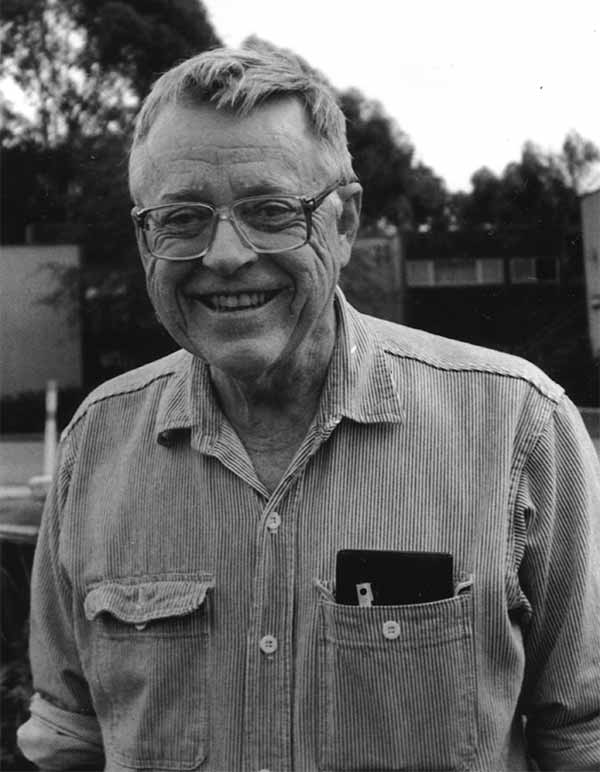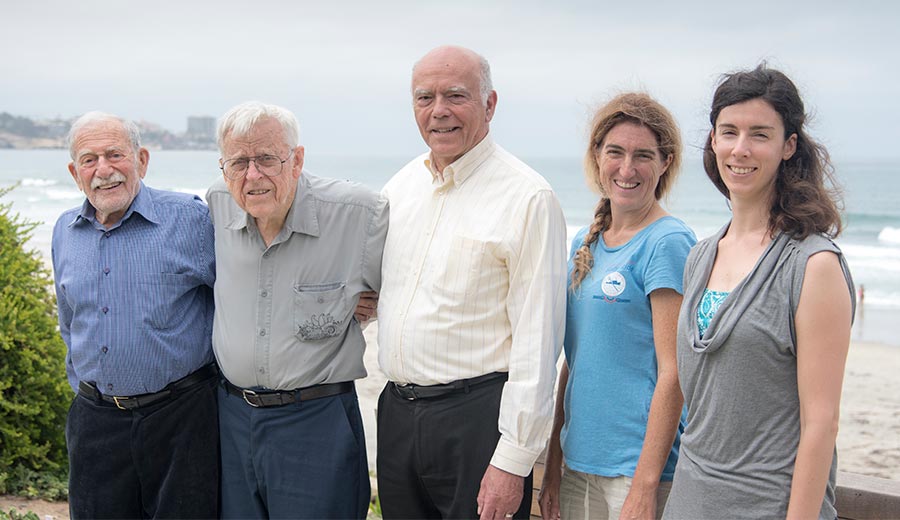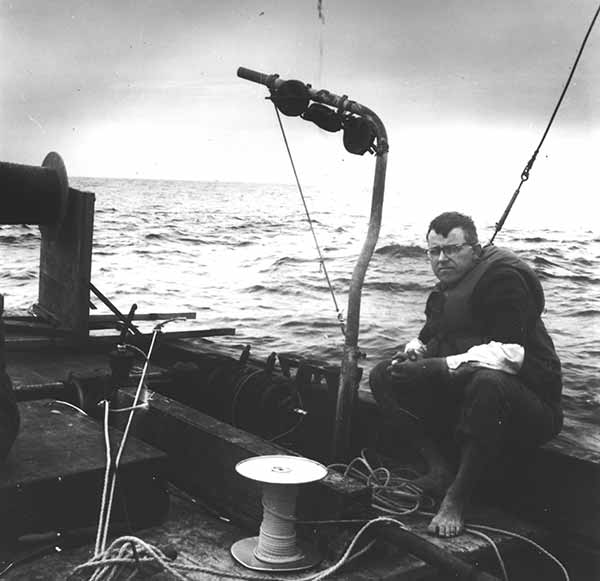Obituary Notice—Charles Cox: Esteemed Scripps Professor of Oceanography
Pioneering researcher, affiliated with Scripps since 1948, explored ocean structures and electromagnetic fields
By:
- Mario Aguilera
Media Contact:
- Mario Aguilera - maguilera@ucsd.edu
- Robert Monroe - scrippsnews@ucsd.edu
Published Date
By:
- Mario Aguilera
Share This:
Article Content
Charles Shipley Cox, a professor emeritus at Scripps Institution of Oceanography at the University of California, San Diego, died of cancer on Nov. 30, 2015, at his home in Del Mar, Calif.

Charles “Chip” Cox
Cox, who was 93, pioneered research in two fields: the electromagnetic field in the ocean and in the earth beneath the deep seafloor; and the fine scale structure of ocean temperature and salinity. For those purposes he pioneered ocean profilers equipped with high-resolution sensors, deployed them at sea and interpreted their records.
“Through the efforts of Chip Cox and his students, the two fields have since become established fields in science, industry and the military,” said Walter Munk, a world-renowned Scripps emeritus research professor of geophysics.
Known to friends and colleagues as “Chip,” Cox was born on Sept. 11, 1922, on Maui, and grew up on Kauai, Hawaii. Initially drawn to biology, he eventually switched disciplines and received a bachelor’s degree in physics from the California Institute of Technology in 1944 and a PhD in oceanography from Scripps in 1954.
“Chip Cox was emblematic of the pioneering spirit of discovery that propelled Scripps for many years and continues today,” said Margaret Leinen, director of Scripps and UC San Diego vice chancellor for marine sciences. “Over nearly seven decades Chip left an indelible legacy in many fields, with his many colleagues, and throughout his mentorship of generations of students.”
His most recent research interest was the ability of oils to smooth stormy seas. He published a historical account on this topic in the International Journal of Maritime History in August and his description of the physics of this phenomena will be published soon. He also philanthropically supported this research with recent donations to the Scripps Hydraulics Laboratory.
Cox, Munk’s first student, went on to mentor his own students and generations thereafter, recently illustrated in a “five generations” portrait in summer 2015.

Five "generations" of ocean scientists came together Aug. 6, 2015, at Scripps Institution of Oceanography at UC San Diego. From left are Scripps geophysicist Walter Munk, who received his doctorate from Scripps in 1947; Munk's student, oceanographer Charles "Chip" Cox, who received his PhD from Scripps in 1954; Cox's student, oceanographer Michael Gregg, who received his PhD at Scripps in 1971; Gregg's student at University of Washington, oceanographer Jennifer Mackinnon, who received her PhD in 2002; and Mackinnon's student at Scripps Caitlin Whalen, who will receive her oceanography PhD this year.
“During his student days, Chip supported himself as a commercial fisherman and for that purpose he had acquired a small old Navy reconnaissance vessel normally manned by a crew of five,” said Munk, who recalls going to sea with Cox in the early 1950s. “Skipper Cox would signal from the bridge to the engine room, then run down below to get engines going, then run on deck to release the mooring lines, etc. A few hours later, ship cook Cox would dish up a delicious luncheon.”
“With his enthusiasm for novel measurements of important variables, Chip was an inspirational advisor for students aspiring to follow him in exploring the ocean using state-of-the-art tools that they developed,” said Mike Gregg, Cox’s former student, now emeritus professor of oceanography at the University of Washington. “He was also a fount of information about other fields, such as the maritime exploration of the Pacific. His impact will be felt in oceanography for many years to come.”
Cox worked as a graduate research oceanographer during his graduate studies at Scripps, and, in 1954, joined the research staff as an assistant research oceanographer, a position he held until July 1960 when he was appointed an associate professor of oceanography. He was elevated to full professor of oceanography and research oceanography in July 1966. He held these positions until his retirement in September 1991.
“Chip tried a lot of crazy things, and they often worked. Attempting things that are totally new and untried is what leads to the biggest advances, so Chip was a true pioneer,” said Spahr Webb, Cox’s former student, now a professor at Columbia University. “He established the field of ocean microstructure as an important field and his efforts were fundamental to the development of electromagnetic methods to probe the seafloor. He was a great mentor to many graduate students.”
“Chip Cox was a pioneer in the study of electromagnetic phenomena in the oceans, developing theory, numerical methods, and instruments,” said Scripps Oceanography Professor Steve Constable. “Along with his colleague Jean Filloux, Chip made the first deep-sea measurements of magnetic and electric fields in the 1960s, and using these data made the first magnetotelluric estimates of seafloor electrical conductivity.”

Charles “Chip” Cox at sea
Cox went on to propose the use of a man-made, or controlled, source of electromagnetic energy to study seafloor electrical conductivity, and developed the necessary theory and instrumentation, making the first seafloor controlled-source electromagnetic measurements in 1979 near a mid-ocean ridge. In the 1990s Chip returned to oceanography full-time, but the marine EM methods he developed are used extensively today, both by academics and by the offshore oil and gas exploration industry.
He had long been interested in making accurate pressure measurements on the seafloor and in the 1980s he developed a sensitive instrument commonly called a “differential pressure gauge,” or DPG. He used this device to study microseismic energy on the seafloor and to identify an extremely quiet window in the seafloor acoustic spectrum, work funded by, and of interest to, the U.S. Navy. At relatively low frequencies the DPG sensor is the best of its type and for this reason is routinely used world-wide on ocean-bottom seismometers to this day.
The author of more than 100 scientific papers, Cox was honored with a National Science Foundation Postdoctoral Fellowship (1957), a Fulbright Postdoctoral Grant (1958), two fellowships from the American Geophysical Union (1980, 1982), the AAAS-Newcomb Cleveland Prize, (1981), the Ewing Medal (1992), and the Alexander Agassiz Medal (2001). He was elected to the National Academy of Sciences in 1996.
He was a member of Sigma Xi, the Royal Astronomical Society, the American Geophysical Union, Tau Beta Pi, and the American Association for the Advancement of Science.
Cox is survived by Maryruth, his wife of 63 years, daughters Caroline Cox, Valerie King, and Ginger Bahardar, son Joel Cox, nine grandchildren, and five great-grandchildren. He was predeceased by daughter Susan Crowder in 1987.
A celebration of his life and work will be held on Dec. 20, 2015, at the home of Walter and Mary Munk, 9530 La Jolla Shores Drive, La Jolla, from 1:30 to 4:30 p.m.
Colleagues wishing to express condolences are invited to submit messages for web posting to scrippsnews@ucsd.edu. A Scripps Archives 2013 oral history interview with Chip Cox by Peter Brueggeman can be heard here.
In lieu of flowers, his family suggests contributions in memory of Chip Cox go to Scripps Institution of Oceanography, UC San Diego, to continue to support the ocean exploration research that Cox was passionate about. Please note that your gift is in memory of Chip Cox, Fund R-57300A Gifts can be sent to:
Scripps Institution of Oceanography
Att: Michele Bart
9500 Gilman Drive, #0210
La Jolla, CA 92093
Share This:
You May Also Like
Engineers Take a Closer Look at How a Plant Virus Primes the Immune System to Fight Cancer
Technology & EngineeringStay in the Know
Keep up with all the latest from UC San Diego. Subscribe to the newsletter today.



